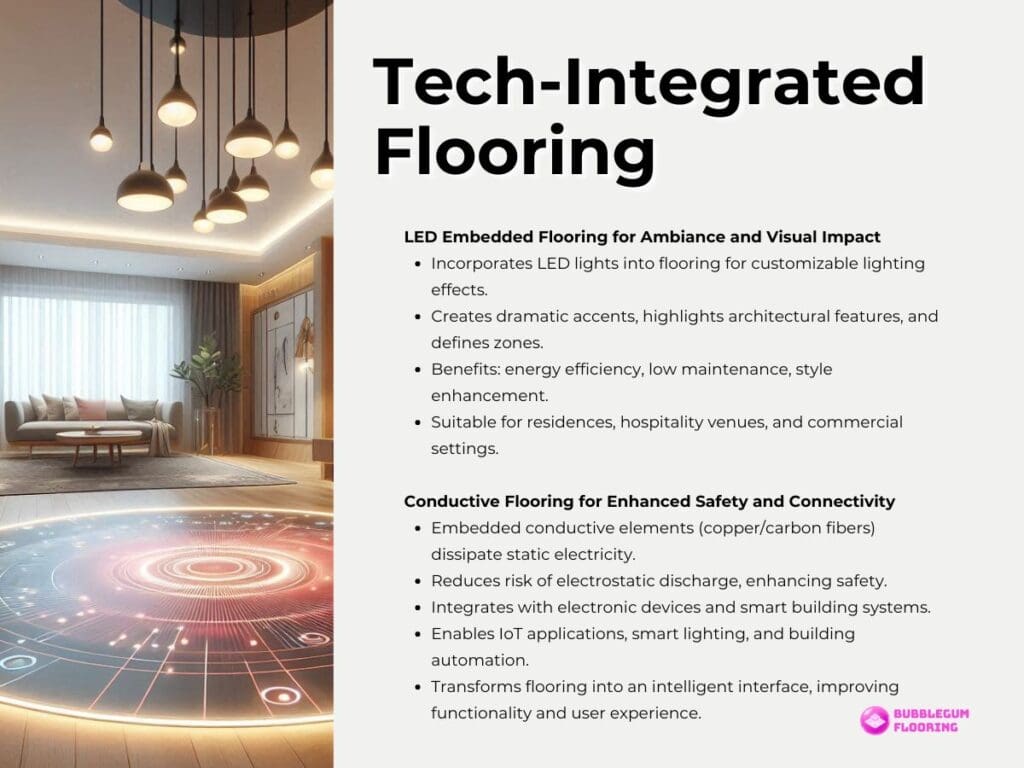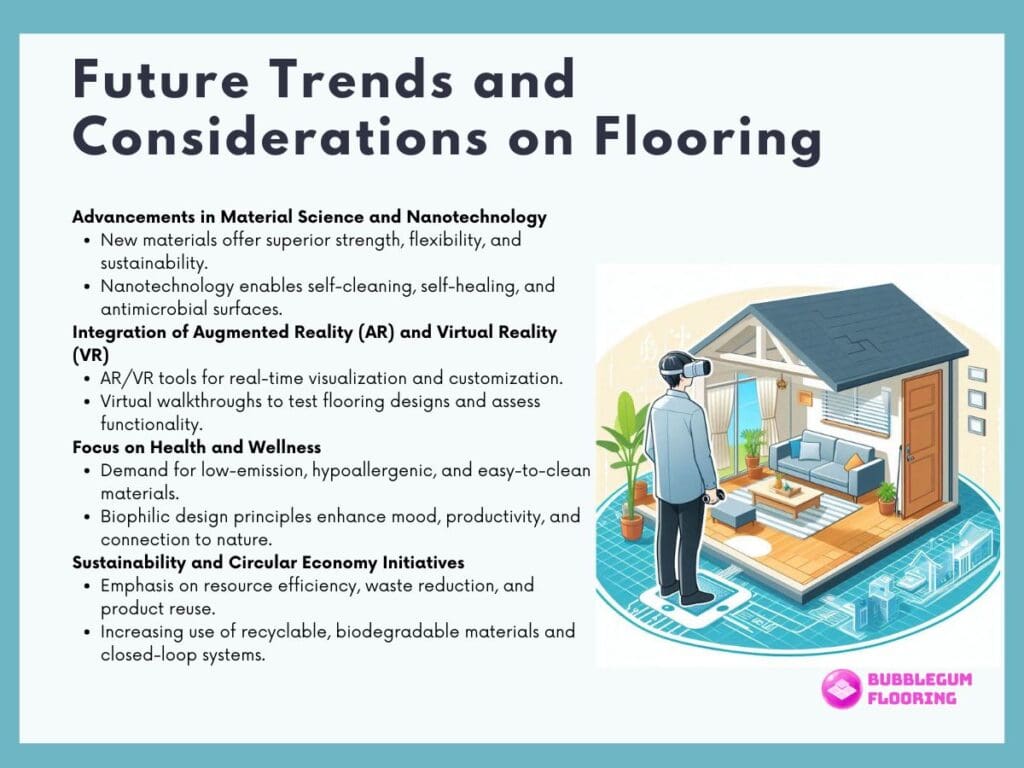Flooring serves as the foundational element of interior design, significantly impacting the aesthetic appeal, functionality, and ambiance of a space. Beyond its basic utility, flooring plays a pivotal role in defining the character and mood of a room, whether it’s a cozy living area, a bustling commercial space, or a serene sanctuary.
The flooring industry has seen a significant transformation in recent years, characterized by the introduction of modern technologies and inventive design ideas that challenge the conventions of traditional flooring solutions. From smart features that enhance comfort and convenience to sustainable materials that prioritize environmental responsibility, the landscape of flooring innovations is vibrant and dynamic. Let’s look at flooring innovations incorporating smart and tech-integrated solutions.
1. Smart Flooring Solutions
In the rapidly evolving landscape of interior design, smart flooring solutions have emerged as a game-changer, offering innovative features that enhance both comfort and functionality. Smart flooring encompasses a range of technologies designed to make our living and working environments more convenient, efficient, and enjoyable.
- Heated Floors for Enhanced Comfort
One of the most notable advancements in smart flooring technology is the integration of heating systems directly into the floor surface. Heated floors provide luxurious warmth underfoot, creating a cozy and inviting atmosphere, particularly in colder climates.
This technology typically involves the installation of electric heating elements or hydronic systems beneath the flooring material, allowing for precise temperature control and energy efficiency. Whether installed in residential bathrooms, commercial lobbies, or outdoor patios, heated floors offer a delightful solution to combat chilly temperatures while adding a touch of indulgence to any space.
- Interactive Flooring for Engaging Experiences
Interactive flooring takes the concept of smart technology to the next level, transforming ordinary floor surfaces into dynamic and engaging platforms. These innovative solutions use sensors, LED lights, and other interactive elements to create immersive experiences that respond to human movement and interaction.
From interactive games and virtual simulations to informative displays and wayfinding systems, the possibilities for interactive flooring are virtually limitless. In retail environments, interactive floors can captivate customers and enhance brand engagement, while in educational settings, they can facilitate experiential learning and sensory exploration.
2. Tech-Integrated Flooring
Innovations in flooring technology have led to the development of tech-integrated flooring solutions, where cutting-edge materials are infused with advanced technologies to enhance performance, aesthetics, and functionality. Tech-integrated flooring represents a fusion of design and engineering, offering solutions that seamlessly integrate into modern living and working environments while providing unique benefits and features.

- LED Embedded Flooring for Ambiance and Visual Impact
LED embedded flooring is a prime example of how technology can be seamlessly integrated into flooring materials to create stunning visual effects and enhance ambiance. These innovative flooring solutions incorporate LED lights directly into the surface, allowing for customizable lighting effects and dynamic color changes.
LED embedded flooring can be used to create dramatic lighting accents, highlight architectural features, or define zones within a space. LED embedded flooring offers practical benefits like energy efficiency and low maintenance, along with a touch of refinement and style, whether it is used in personal residences, hospitality venues, or commercial settings.
- Conductive Flooring for Enhanced Safety and Connectivity
Conductive flooring is another tech-integrated solution that leverages advanced materials to improve safety and connectivity in interior spaces. Designed with embedded conductive elements, such as copper or carbon fibers, conductive flooring creates a low-resistance path for electrical currents, effectively dissipating static electricity and reducing the risk of electrostatic discharge.
In addition to enhancing safety, conductive flooring also enables seamless integration with electronic devices and smart building systems. This connectivity allows for the implementation of IoT (Internet of Things) applications, such as sensor networks, smart lighting controls, and building automation systems, transforming the floor into an intelligent interface that enhances overall functionality and user experience.
3. Sustainable Flooring Innovations
As awareness of environmental issues grows, there is a growing demand for sustainable flooring solutions that minimize ecological impact while still offering durability, functionality, and aesthetic appeal. Sustainable flooring innovations encompass a wide range of materials and design approaches aimed at reducing carbon footprints, conserving natural resources, and promoting healthier indoor environments.
- Recycled Materials for Eco-Friendly Flooring
Recycling has become a cornerstone of sustainable flooring innovation, with manufacturers repurposing materials such as reclaimed wood, recycled rubber, and post-consumer plastics to create new flooring products. These recycled materials not only divert waste from landfills but also reduce the need for virgin resources, making them a more environmentally responsible choice.
Recycled rubber flooring, for example, offers excellent durability and resilience, making it suitable for high-traffic areas such as gyms and sports facilities. Similarly, reclaimed wood flooring adds a rustic charm to interior spaces while conserving forests and reducing deforestation.
- Bamboo and Cork for Renewable Flooring
Bamboo and cork are two renewable materials that have gained popularity in the sustainable flooring market due to their rapid renewability and eco-friendly properties. Bamboo, a fast-growing grass, can be harvested sustainably without causing harm to the environment, making it an excellent alternative to traditional hardwood flooring.
Cork, derived from the bark of cork oak trees, is similarly renewable and offers natural thermal and acoustic insulation properties. Both bamboo and cork flooring are durable, versatile, and biodegradable, making them ideal choices for environmentally conscious consumers seeking stylish and sustainable flooring options.
- Low-Emission Flooring for Improved Indoor Air Quality
Indoor air quality is a significant concern in modern building design, with volatile organic compounds (VOCs) emitted by certain flooring materials contributing to indoor air pollution. Sustainable flooring innovations address this issue by offering low-emission options that minimize VOC off-gassing and promote healthier indoor environments.
For example, linoleum flooring, made from natural materials such as linseed oil, wood flour, and cork dust, emits fewer VOCs than traditional vinyl flooring, making it a preferred choice for eco-conscious homeowners and commercial developers. Similarly, carpet tiles with low-VOC adhesives and backing materials provide a sustainable and healthier alternative to conventional broadloom carpeting.
4. Interactive and Adaptive Flooring
Innovations in flooring technology have paved the way for the development of interactive and adaptive flooring solutions, which transform static floor surfaces into dynamic and responsive environments. While adaptive flooring changes its features in reaction to changing situations, enabling flexible and adaptable places that cater to varied needs and preferences, interactive flooring engages users through sensory input and interactive aspects.
- Kinetic Flooring for Energy Generation and Engagement
Kinetic flooring harnesses the power of human movement to generate energy and create immersive interactive experiences. They are equipped with sensors or piezoelectric materials that convert mechanical energy from footsteps into electrical energy, which can be used to power lighting, electronics, or other building systems.
Kinetic flooring installations can also incorporate interactive elements such as LED lights or sound effects, transforming pedestrian pathways, fitness centers, or public spaces into engaging environments that encourage physical activity and social interaction.
- Pressure-Sensitive Flooring for Dynamic Environments
Pressure-sensitive flooring utilizes advanced sensors and materials to detect changes in pressure and respond accordingly, enabling real-time adjustments to flooring properties and functionality. The floors can detect the presence and movement of people, objects, or vehicles, triggering automated responses such as lighting adjustments, wayfinding signals, or safety alerts.
Pressure-sensitive flooring is particularly well-suited for applications in healthcare facilities, retail environments, and smart cities, where real-time data and dynamic environments are essential for optimizing operations and enhancing user experience.
- Shape-Shifting Flooring for Flexible Spaces
Shape-shifting flooring represents a cutting-edge approach to adaptive flooring design, where floor surfaces can be dynamically reconfigured to accommodate changing needs and activities. The flooring systems use modular or programmable elements that can change shape, texture, or color in response to user input or environmental conditions.
Shape-shifting flooring offers endless possibilities for creating flexible and adaptable spaces, from transforming conference rooms for different meeting formats to optimizing retail layouts for seasonal promotions.
Future Trends and Considerations
As the flooring industry continues to evolve, several emerging trends and considerations are shaping the future of flooring innovation. From advancements in materials science to shifts in consumer preferences and sustainability initiatives, these trends are poised to influence the trajectory of flooring design and technology in the years to come.

- Advancements in Material Science and Nanotechnology
The future of flooring innovation is closely tied to advancements in material science and nanotechnology, which are unlocking new possibilities for enhanced performance, durability, and sustainability. Engineers and scientists are exploring novel materials and manufacturing techniques that offer superior strength, flexibility, and environmental compatibility compared to traditional flooring materials.
Nanotechnology, in particular, holds promise for creating self-cleaning, self-healing, and antimicrobial flooring surfaces that require minimal maintenance and contribute to healthier indoor environments.
- Integration of Augmented Reality and Virtual Reality
Augmented reality (AR) and virtual reality (VR) technologies are poised to revolutionize the way we envision, design, and experience flooring solutions. Designers and consumers can use AR and VR tools to visualize different flooring options in real-time, allowing for more informed decision-making and customization.
These immersive technologies also enable interactive experiences where users can virtually walk through spaces, test different flooring designs, and assess their impact on aesthetics and functionality.
- Focus on Health and Wellness
The importance of health and wellness in building design is driving demand for flooring solutions that promote occupant well-being and indoor air quality. Manufacturers are increasingly prioritizing materials and finishes that are low-emission, hypoallergenic, and easy to clean, reducing the risk of indoor pollutants and allergens.
Additionally, there is growing interest in biophilic design principles, which incorporate elements of nature into interior spaces to improve mood, productivity, and cognitive function. Flooring solutions that mimic natural textures, patterns, and colors can help create environments that foster relaxation, inspiration, and connection to the outdoors.
- Sustainability and Circular Economy Initiatives
Sustainability remains a key focus area for the flooring industry, with manufacturers and designers seeking to minimize environmental impact throughout the product lifecycle. Circular economy principles, which prioritize resource efficiency, waste reduction, and product reuse, are driving innovation in materials sourcing, manufacturing processes, and end-of-life management.
Recyclable and biodegradable flooring materials, closed-loop manufacturing systems, and take-back programs are becoming increasingly common, allowing for the responsible disposal and repurposing of flooring products.
Innovative Flooring Solutions for Pet Owners
Innovative flooring solutions are not only transforming interior spaces but also addressing the unique needs of pet owners. For those who share their homes with furry companions, flooring durability, ease of maintenance, and resistance to scratches and stains are essential considerations.
Innovative flooring options cater to these needs by offering materials and technologies specifically designed to withstand the rigors of pet ownership. Smart flooring solutions equipped with moisture-resistant and odor-control features are particularly beneficial for pet owners, helping to manage accidents and maintain a fresh living environment.
Tech-integrated materials such as stain-resistant carpets and scratch-resistant laminates provide peace of mind, alleviating concerns about damage caused by pets’ claws or spills. As the flooring industry continues to innovate, pet owners can expect even more tailored solutions that enhance their living experience and nurture their bond with their beloved pets, ensuring a harmonious and comfortable home environment for all.


